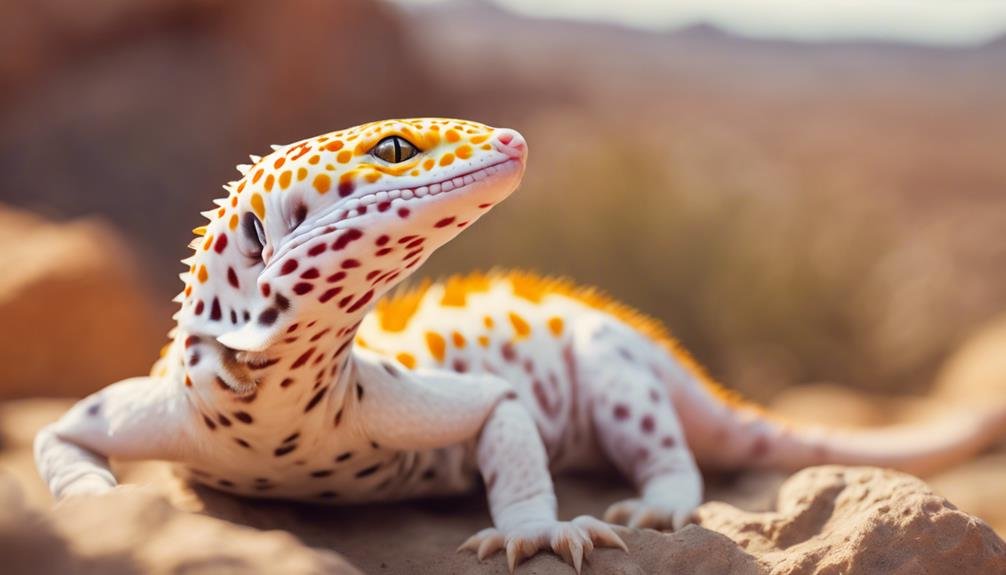You might find the Albino Leopard Gecko fascinating due to its unique genetic makeup and striking appearance. Unlike typical geckos, these albino variants lack melanin, giving them a range of lighter colors from peach to yellow and even silver-toned eyes. Considering their popularity, it’s important to understand the care they require, including specific dietary needs and appropriate lighting. But how do these intriguing creatures exist, and what should you know about their genetic traits and common morphs? Let’s explore the essentials that make the Albino Leopard Gecko a unique and delicate pet.
Key Takeaways
- Albino Leopard Geckos were first discovered by Ron Tremper in 1996.
- They have lighter colors and striking eye hues due to the absence of melanin.
- The main albino morphs include Tremper, Rainwater, and Bell, each with unique traits.
- Albino Leopard Geckos require proper lighting, a carnivorous diet, and a habitat mimicking natural conditions.
- Responsible breeding focuses on health, avoiding inbreeding, and maintaining genetic integrity.
History and Origins
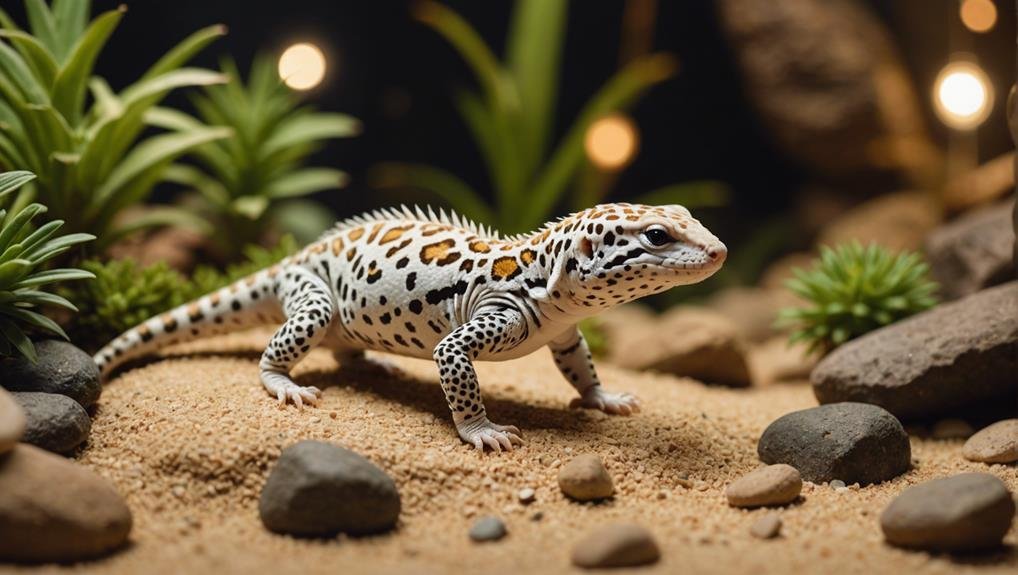

Have you ever wondered how the alluring Tremper Albino leopard geckos existed? It all began with Ron Tremper, a pioneer in reptile breeding. In 1996, Ron Tremper discovered the first strain of albino leopard geckos, marking a significant milestone in the herpetology community. These geckos, now known as Tremper Albino Leopards, captivated enthusiasts with their unique and vibrant appearance.
The journey to successfully breed these albino leopard geckos wasn’t easy. It took Ron Tremper several years of dedication and experimentation. By April 1999, he’d achieved a breakthrough, successfully breeding a stable line of Tremper Albino leopard geckos. One gecko, in particular, named Rosie, played a pivotal role in this development. Rosie’s genetic traits and successful breeding outcomes created this distinct morph.
Over the years, albino leopard gecko morphs have continued to evolve, but the Tremper Albino remains the oldest and most common. This history highlights the progress in breeding techniques and showcases Ron Tremper’s monumental contributions to the reptile world. The Tremper Albino leopard gecko reflects his dedication and innovation.
Physical Characteristics
Albino leopard geckos, lacking melanin, showcase a striking array of lighter and brighter colors compared to their non-albino counterparts. You’ll notice their unique coloration ranges from peach to yellow, with some individuals retaining intricate patterns while others are completely patternless. This distinct variation makes them fascinating and easily distinguishable from regular leopard geckos.
One of the most enchanting features of albino leopard geckos is their eye color. They can have eyes that range from a soft peach to a shimmering silver, further enhancing their unique appearance. This variation in eye color adds an extra layer of allure and makes each gecko truly one-of-a-kind.
A notable example is the Bell Albino Leopard gecko, which often displays a blend of light yellows and oranges, creating a visually stunning reptile. Depending on the specific albino morph, you might find geckos with colorless skin in all or just particular layers, leading to various visual effects.
These shades can range from dark browns to light yellows and oranges, providing a rich palette of hues that make albino leopard geckos particularly striking and diverse.
Common Morphs
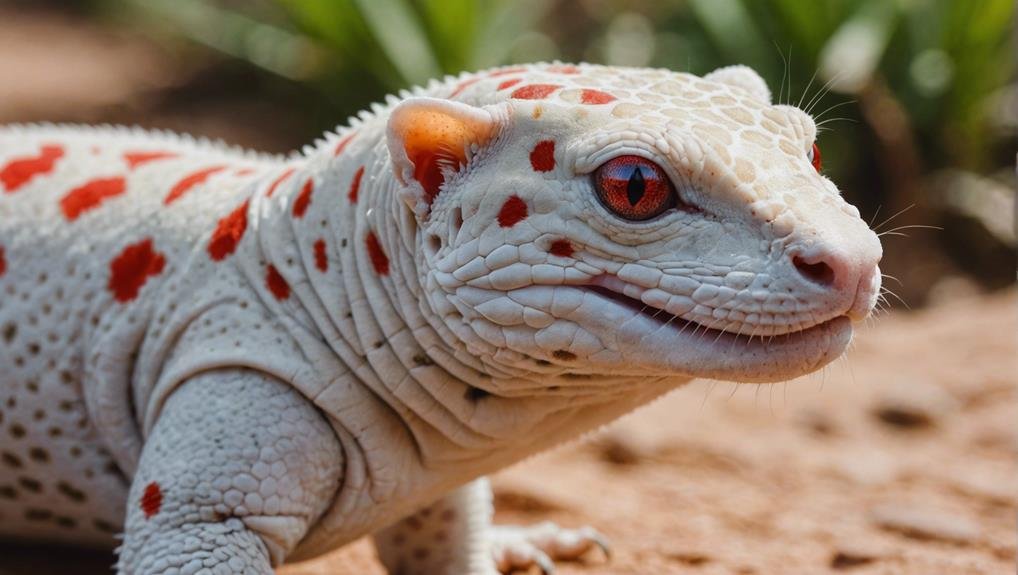

Exploring the common morphs of albino leopard geckos reveals a fascinating diversity of colors and patterns, each with its unique charm and history. The Tremper albino, discovered in 1996, is the oldest and most common morph. Tremper albinos are known for their light-coloured eyes and soft, pastel hues, making them a favorite among enthusiasts.
Next, you have the Rainwater Albino, also called the Las Vegas albino. This morph is distinctive because it’s the smallest of the albino morphs. Rainwater Albinos typically cost between $400 and $450, reflecting their unique characteristics and relative rarity. Their lighter coloration and delicate patterns make them stand out in any collection.
Lastly, there are Bell albinos, the latest addition to the albino morph family. What sets Bell albinos apart is their unique pinkish eye color. These geckos can range in price from $300 to $700, depending on their specific traits and quality. Bell albinos are highly sought after for their striking appearance and reflect the ongoing evolution of leopard gecko breeding.
Each of these common albino morphs offers something special, making the world of leopard geckos endlessly intriguing and diverse.
Genetic Traits
Genetic traits are essential in defining the unique characteristics of albino leopard geckos, as they directly influence the absence of melanin in their skin and eyes. This lack of melanin is the hallmark of people with albinism, giving them their distinctive pale coloration and pinkish eyes.
Because these traits are genetic, they can be carefully managed through selective breeding to enhance specific color and pattern traits, creating unique Leopard Gecko Morph varieties.
However, breeding albino morphs requires careful consideration. Health concerns may arise from breeding practices focused solely on aesthetics, leading to potential genetic weaknesses. It’s important to prioritize the gecko’s overall health and well-being when planning any breeding program.
Cross-breeding different albino morphs is generally discouraged to preserve the purity and genetic identification of each specific morph. This helps maintain the genetic integrity and distinct characteristics of each type of albino leopard gecko.
To make informed breeding decisions and accurately identify albino morphs, you should always seek expert advice. Understanding the genetic background of your geckos ensures that you’re making responsible breeding choices that contribute positively to the species and maintain the vibrant diversity of albino leopard geckos.
Care Requirements
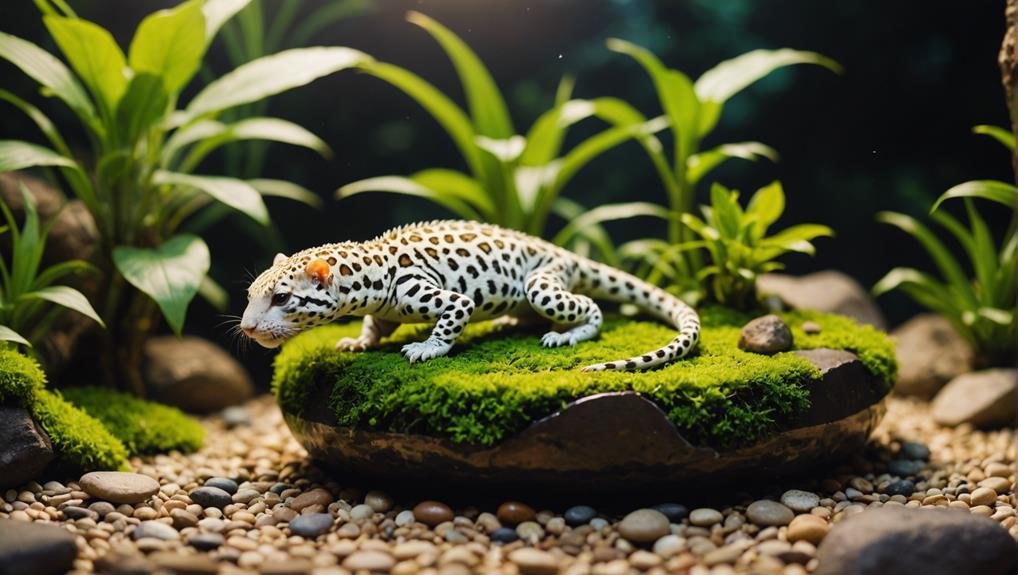

When caring for your albino leopard gecko, it’s important to provide a carnivorous diet rich in feeder insects like beetles, crickets, and roaches. Ensuring their habitat mimics their natural environment is fundamental for their well-being. While they’re not sensitive to light, offering hides for daylight hours gives them a safe, comfortable place. Also, they prefer dimmer environments and avoid bright lights due to their nocturnal nature.
Though UVB lighting isn’t necessary, it can benefit their overall health and immune system. Some owners find that some UVB exposure encourages natural behaviors and enhances their gecko’s overall vitality. Offering a varied diet also ensures that your leopard gecko receives all the essential nutrients, promoting a healthy, active life.
Here’s a quick reference to evoke the importance of proper care:
| Aspect | Importance | Emotional Impact |
|---|---|---|
| Diet | Ensures growth and vitality | Watching them thrive and grow |
| UVB Lighting | Boosts immune system | Peace of mind in their health |
| Hides | Provides comfort and security | Knowing they feel safe and happy |
Diet and Nutrition
A well-balanced diet for your albino leopard gecko is important for overall health and vitality. Like other morphs such as Bell, Tremper, and Super Snow, your albino leopard gecko thrives on a carnivorous diet. You’ll need to provide feeder insects like beetles, crickets, and roaches regularly to meet their nutritional needs.
Varying their diet is essential. Offering a mix of different feeder insects ensures your gecko receives all the vital nutrients. Crickets are a staple, but don’t forget to include roaches and beetles to diversify their meals. Each type of insect offers different nutritional benefits, contributing to your gecko’s well-being.
Remember to gut-load the insects before feeding them to your gecko. Gut-loading means feeding the insects nutritious food 24 hours before offering them to your reptile. This process enhances the nutrient content of the insects, providing a better diet for your albino leopard gecko.
Another important aspect is dusting the feeder insects with calcium and vitamin D3 supplements. This helps prevent nutritional deficiencies, ensuring your gecko remains healthy.
Even though UVB lighting isn’t mandatory, it can still be beneficial for their immune system and overall health.
Sensitivity to Light
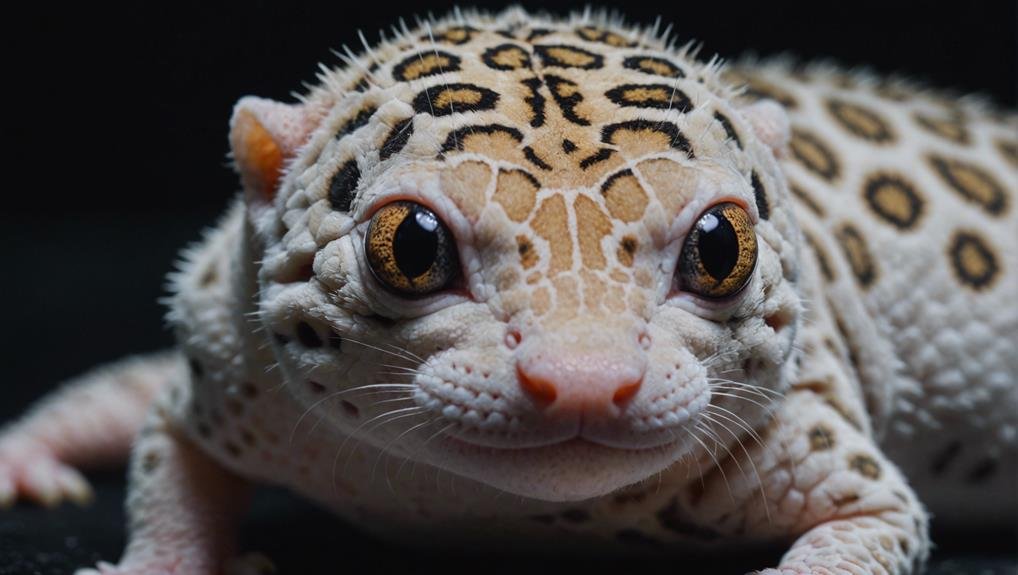

While guaranteeing your albino leopard gecko receives proper nutrition, it’s equally important to consider their heightened sensitivity to light due to their albinism.
Because these animals can’t filter light effectively, their silver eyes are prone to photophobia. This isn’t a fear of light but a physical sensitivity resulting from the lack of pigment in their irises. Consequently, your gecko will naturally avoid bright lights and prefer dimly lit environments.
To accommodate this sensitivity, you should:
- Provide shaded areas: Make sure your gecko’s habitat includes plenty of hiding spots to retreat from intense light.
- Use low-intensity lighting: Opt for softer lights to reduce the strain on their eyes.
- Monitor lighting duration: Keep artificial lighting limited to simulate a natural day-night cycle.
- Choose appropriate basking spots: Ensure basking areas aren’t overly bright, as excessive light can cause discomfort.
- Avoid direct sunlight: Keep the habitat out of direct sunlight, which can be too harsh for your gecko’s delicate eyes.
Breeding Information
Breeding albino leopard geckos demands meticulous planning to guarantee healthy and desirable offspring. When you’re entering the world of breeding for the first time, it’s important to focus on selective breeding to secure the desired genetic traits in your geckos. Pairing individuals with specific characteristics, such as unique color morphs from Las Vegas strains, can yield stunning results.
Genetic considerations are vital. You’ll need to understand the genetic background of your geckos to predict the color and characteristics of the hatchlings accurately. Cross-breeding different albino morphs can sometimes dilute the purity of the offspring, making it harder to identify specific traits. Keep detailed records of your breeding pairs and their lineage to avoid confusion.
Health concerns are another critical aspect. Inbreeding can lead to genetic defects, so avoid pairing closely related geckos. It’s important to seek expert advice to make informed decisions and guarantee the overall health of your breeding program.
When housing your breeding pairs, remember that albino leopard geckos are sensitive to bright light. Providing appropriate lighting conditions will help maintain their well-being.
With careful planning and attention to detail, your breeding efforts can yield vibrant, healthy albino leopard geckos.
Conclusion
Taking care of an Albino Leopard Gecko is both rewarding and intriguing. By understanding their unique history, physical traits, and dietary needs, you guarantee they thrive.
Paying attention to their sensitivity to light and proper breeding practices helps maintain their health and vibrant colors. With proper care, your gecko will remain a stunning and healthy companion, showcasing the beauty and diversity of these fascinating reptiles.
Enjoy the journey with your Albino Leopard Gecko!

